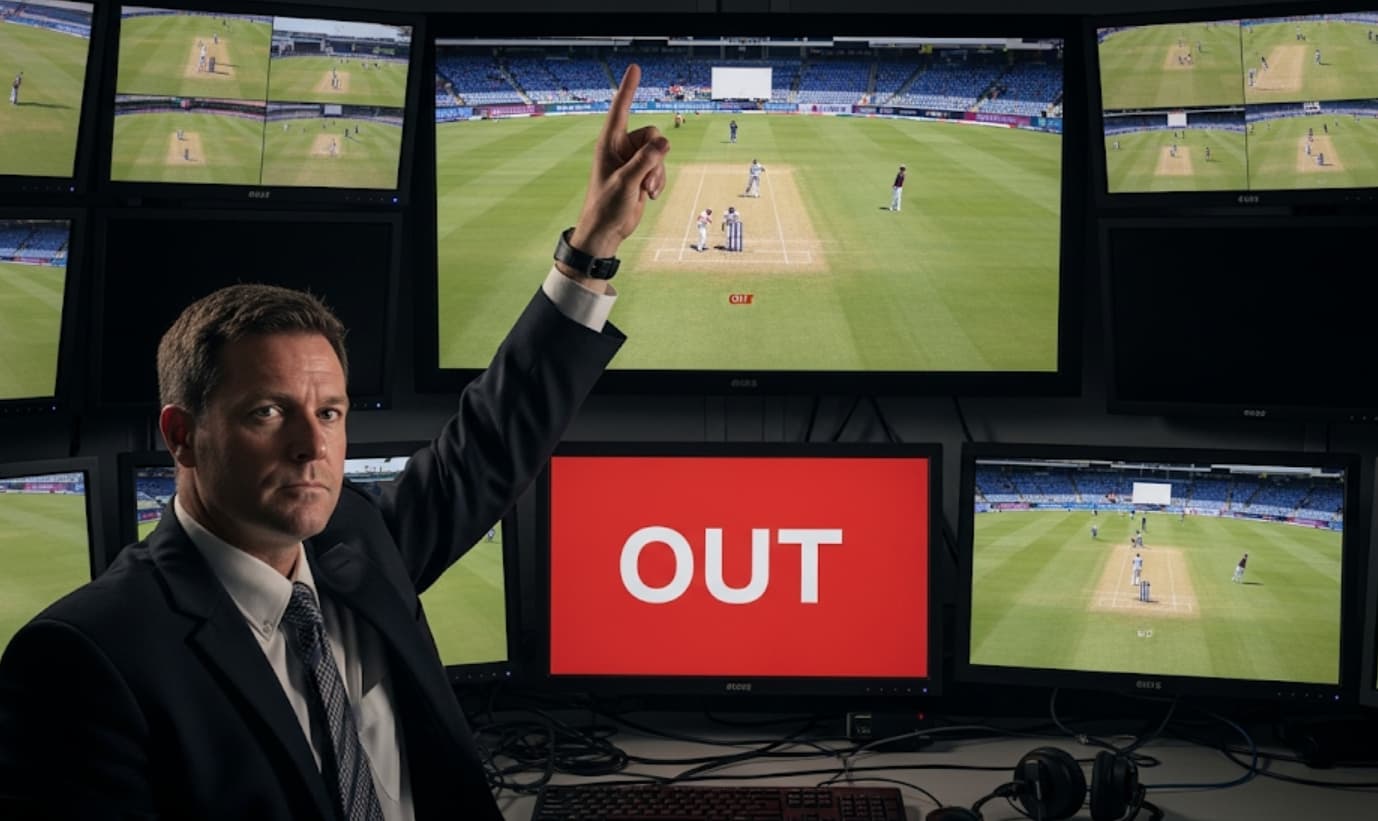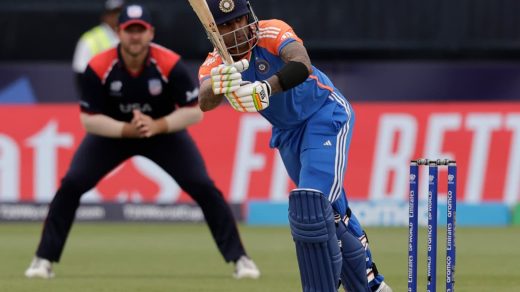Cricket is a game that has changed a lot over the years. New rules, better equipment, and most importantly, technology have made the sport more exciting and fair.
But there’s one moment in cricket history that changed everything forever. On November 14, 1992, something happened that no one had ever seen before in international cricket.
who was the first player to be given out by the third umpire? The answer is Sachin Tendulkar, India’s batting legend. This wasn’t just any ordinary dismissal.
It was the first time ever that a player was given out using television replays and a third umpire’s decision.
This moment happened during a Test match between India and South Africa at Kingsmead Stadium in Durban.
Before this historic day, all cricket decisions were made by two umpires on the field. They had to make split-second judgments using only their eyes.
Sometimes they got it right, sometimes they didn’t. But on that November day in 1992, cricket took its first big step into the modern era.
The introduction of the third umpire system wasn’t just about one dismissal – it was about making cricket fairer and more accurate for everyone.
Who Was The First Player To Be Given Out By The Third Umpire?

This moment involving young Sachin Tendulkar became a turning point that would eventually lead to all the technology we see in cricket today.
From DRS (Decision Review System) to Hawkeye, it all started with this one run-out decision in South Africa.
Recap of India vs South Africa 1st Test Match on 13-17 November 1992
The match that made cricket history took place at the beautiful Kingsmead Stadium in Durban. This was during India’s tour of South Africa, and it was a big deal because South Africa had just returned to international cricket after years of isolation.
Here’s what happened in this important match:
| Innings | Team | Score | Result |
|---|---|---|---|
| 1st Innings | South Africa | 254 All Out | Complete |
| 1st Innings | India | 277 All Out | Complete |
| 2nd Innings | South Africa | 176/3 | Incomplete |
| 2nd Innings | India | Did Not Bat | Match Drawn |
Key Match Details:
- Venue: Kingsmead, Durban, South Africa
- Dates: November 13-17, 1992
- Match Result: Draw (due to rain)
- Historic Moment: First third umpire decision
- Weather Impact: Rain affected play on days 3 and 4
The match was important for several reasons. First, it was part of India’s first Test series in South Africa after the country’s readmission to international cricket. Second, it became the testing ground for cricket’s new technology experiment – the third umpire system.
Weather played a big role in this match. Rain interrupted play on the third and fourth days, which meant the match couldn’t reach a proper conclusion. But despite the weather problems, this match will always be remembered for that one special moment involving Sachin Tendulkar.
How Did Sachin Get Run Out?
The moment that changed cricket forever happened during India’s first innings. Sachin Tendulkar was batting and looking comfortable at the crease. He was just 19 years old at that time but was already showing signs of becoming a great player.
Here’s exactly what happened:
- Sachin tried to take a quick single
- The ball went to Jonty Rhodes, who was known as one of the best fielders in the world
- Rhodes picked up the ball and threw it at the stumps with lightning speed
- The ball hit the stumps, but was Sachin in or out?
- The on-field umpires couldn’t tell for sure
- For the first time ever, they asked the third umpire to help
The Third Umpire’s Decision Process:
- Third Umpire: Karl Liebenberg
- Technology Used: Television replays
- Angles Available: Multiple camera views
- Decision Time: A few minutes of careful review
- Final Decision: OUT – Sachin was short of the crease
The field umpire made a signal to the third umpire, and Karl Liebenberg watched the TV replays carefully. After looking at different angles, he decided that Sachin was just short of reaching the crease safely. The red light came on, and history was made.
Why This Run-Out Was Special:
- It involved Jonty Rhodes, famous for amazing fielding
- The decision was extremely close – perfect for testing new technology
- It happened to Sachin Tendulkar, who would become cricket’s biggest star
- The technology worked perfectly on its first try
Who Won The Match?
The match between India and South Africa ended in a draw, but not because both teams played all their innings. Weather was the real winner in this game.
Match Progression:
- Day 1-2: Both teams completed their first innings
- Day 3: Rain stopped play early
- Day 4: More rain delays
- Day 5: South Africa batted and scored 176/3 before time ran out
South Africa was in a good position in their second innings when the match ended. They had scored 176 runs for the loss of only 3 wickets. If the weather had been better, we might have seen a really exciting finish to this historic match.
Final Match Statistics:
| Team Performance | India | South Africa |
|---|---|---|
| 1st Innings Total | 277 | 254 |
| 2nd Innings Total | Did Not Bat | 176/3 |
| Match Result | Draw | Draw |
| Playing Days Lost | 1.5 days | 1.5 days |
Even though the match was drawn, it will always be remembered for introducing technology to cricket rather than for the final result. Sometimes, the most important games aren’t about who wins or loses, but about what they bring to the sport.
History Behind The Third Umpire System
The third umpire system didn’t just appear out of nowhere. Cricket officials had been thinking about it for years because of several close decisions that caused arguments between players and teams.
Why Was The Third Umpire Needed?
- Human Error: Even the best umpires make mistakes
- Close Decisions: Some calls were too close for naked eye judgment
- Player Arguments: Controversial decisions led to disputes
- Television Evidence: TV replays showed what really happened
- Fairness: Technology could make the game more fair
Development Timeline:
- 1980s: TV replays showed many wrong decisions
- Early 1990s: Cricket boards discussed using technology
- 1992: South Africa agreed to test the system
- November 1992: First official use in international cricket
- Later 1990s: System expanded to more situations
How The System Worked in 1992:
- On-field umpire wasn’t sure about a decision
- Signal sent to third umpire in TV control room
- Third umpire watched multiple replay angles
- Decision communicated back through lights system
- Red light meant OUT, green light meant NOT OUT
The system was much simpler than what we have today. There was no DRS, no player reviews, and no ball-tracking technology. But it was a huge step forward from making all decisions with just two pairs of eyes on the field.
Countries That Adopted It First:
- South Africa (1992) – First country to use it
- England (1993) – Second country to adopt
- Australia (1992-93) – Used it in home series
- Other countries gradually followed
Why Sachin’s Run Out Matters For Cricketing History
Sachin Tendulkar being given out by the third umpire wasn’t just about one player losing his wicket. It was about cricket changing forever. This moment started a revolution in how cricket decisions are made.
Immediate Impact on Cricket:
- Proof of Concept: The technology worked perfectly
- Player Acceptance: Players saw it was fair
- Umpire Support: Field umpires welcomed the help
- Viewer Interest: Fans enjoyed seeing replays
- Media Coverage: The decision got worldwide attention
Long-Term Changes This Decision Started:
For Players:
- More confident running between wickets
- Better understanding of close decisions
- Acceptance of technology in cricket
- Reduced arguments with umpires
For Umpires:
- Support system for difficult decisions
- Reduced pressure on field umpires
- Better accuracy in decision-making
- Shared responsibility for tough calls
For Cricket Fans:
- More excitement during close calls
- Better understanding of decisions
- Increased trust in officiating
- Enhanced viewing experience
Technologies That Followed:
- Hawk-Eye – Ball tracking technology
- Hot Spot – Edge detection system
- Snickometer – Sound-based edge detection
- DRS – Complete review system
- Ball tracking for LBW decisions
Why Sachin Being First Was Perfect:
- He was already a popular young player
- The decision was clearly correct when replayed
- It involved exciting fielding by Jonty Rhodes
- No controversy surrounded the decision
- It showed technology could handle high-pressure situations
Quick Recap of The Incident
Let’s look at all the important details about this historic moment in cricket:
Match Information:
- Date: November 14, 1992
- Match: India vs South Africa, 1st Test
- Venue: Kingsmead Stadium, Durban
- Match Status: India’s 1st innings
Key People Involved:
- Player Dismissed: Sachin Tendulkar (age 19)
- Fielder: Jonty Rhodes (South Africa)
- Third Umpire: Karl Liebenberg
- On-field Umpires: Cyril Mitchley and Brent Bowden
The Dismissal Details:
- Type: Run out
- Attempt: Quick single
- Throw: Direct hit by Jonty Rhodes
- Decision: Given out after TV replay review
- Time Taken: Approximately 2-3 minutes
Historical Significance:
- First Ever: Third umpire decision in international cricket
- Technology: Television replay system
- Result: OUT – Sachin short of crease
- Impact: Started cricket’s technology revolution
What Made It Special:
| Aspect | Details |
|---|---|
| Player Involved | Sachin Tendulkar – Future cricket legend |
| Fielding | Jonty Rhodes – Best fielder of his era |
| Decision | Extremely close call |
| Technology | Worked perfectly on first attempt |
| Acceptance | No disputes or controversies |
This moment proved that technology and cricket could work together to make the game fairer and more exciting.
FAQs
Q1: who was the first player to be given out by the third umpire? A: Sachin Tendulkar was the first player to be given out by the third umpire on November 14, 1992, during the India vs South Africa Test match in Durban.
Q2: What type of dismissal was it? A: It was a run-out. Sachin was attempting a quick single when Jonty Rhodes threw the ball at the stumps.
Q3: Who was the third umpire who made this historic decision? A: Karl Liebenberg was the third umpire who reviewed the television replays and gave Sachin out.
Q4: Was the decision correct?
A: Yes, the replays clearly showed that Sachin was short of the crease when the bails were removed.
Q5: Did this decision cause any controversy? A: No, there was no controversy. Everyone accepted that the technology had made the correct decision.
Q6: What technology was used in 1992? A: Only basic television replays were used. There was no ball-tracking, Hot Spot, or other advanced technologies we see today.
Q7: How long did the decision take? A: The third umpire took approximately 2-3 minutes to review the replays before making the decision.
Q8: Did Sachin object to being given out? A: No, Sachin accepted the decision and walked off. He understood that the replays showed he was out.
Q9: What happened to the match? A: The match ended in a draw due to rain interruptions on multiple days.
Q10: How did this change cricket? A: This decision started cricket’s journey toward using technology, eventually leading to DRS and other modern systems.
Useful Resources for Cricket Fans
Here are some trusted websites where you can learn more about cricket history and technology:
Official Cricket Resources:
For more information about cricket history and technology:
- Visit ICC Official Website (icc-cricket.com) for comprehensive cricket rules and history
- Check ESPNCricinfo (espncricinfo.com) for detailed match statistics and historical records
- Explore Cricket Australia (cricket.com.au) for insights into cricket technology development
- Read BCCI Official Site (bcci.tv) for Indian cricket history and developments
- Read Latest Cricket Updates Online at (TheTopPlayers.com)
Technology in Cricket:
- Hawk-Eye Innovations: Official ball-tracking technology
- Cricket Technology: Understanding DRS and review systems
- Match Statistics: Historical data and records
Conclusion
The story of who was the first player to be given out by the third umpire is much more than just a cricket trivia question. It’s the story of how cricket embraced change and became a more fair and exciting sport.
When Sachin Tendulkar walked back to the pavilion that day in Durban, he probably didn’t realize he had just made cricket history. He was just a 19-year-old player who had been run out in a Test match. But that dismissal started a technology revolution that continues today.
Key Takeaways from This Historic Moment:
- Technology can improve sports without taking away from the human element
- Cricket was ready for change in the 1990s
- Close decisions became fair decisions with replay technology
- Players, umpires, and fans all benefited from the system
- One moment can change everything – even in traditional sports like cricket
Today, when we see DRS reviews, ball tracking, and edge detection in cricket, we should remember where it all started. It began with a young Sachin Tendulkar, a brilliant piece of fielding by Jonty Rhodes, and cricket’s willingness to try something new.
The third umpire system proved that tradition and technology could work together to make cricket better. This decision in 1992 wasn’t just about who was the first player to be given out by the third umpire – it was about cricket taking its first step into the modern age.
Cricket fans around the world should be grateful for this moment. It made the game fairer, more accurate, and more exciting. And it all started with one close run-out decision in Durban, South Africa, more than 30 years ago.
From that day forward, cricket has never been the same – and that’s a very good thing for everyone who loves this beautiful game.


